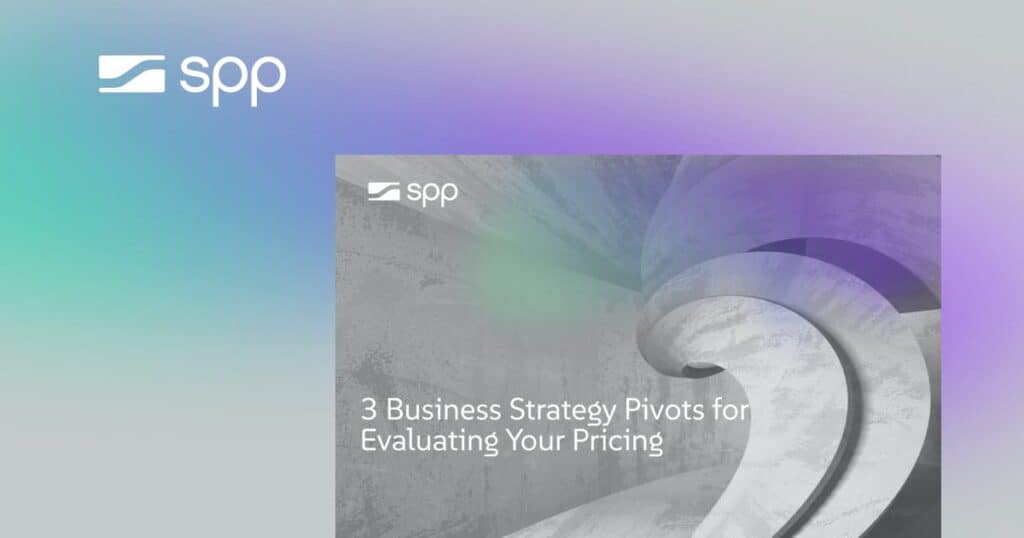TL;DR
Most software companies wait too long to fix their B2B pricing strategies, missing early warning signs like inconsistent deal sizes, flat revenue despite product improvements, and rising customer acquisition costs that signal pricing problems before they damage margins. The optimal time to implement strategic pricing changes is when these data-driven indicators first appear, using technology-powered platforms to create continuous monetization systems that enable your team to adapt to market conditions in real-time.
When to Create Your B2B Pricing Strategies
Most software companies make a critical mistake: They wait until revenue starts declining before analyzing or fixing their pricing. By then, discount erosion has already damaged margins, and competitors have gained ground. Resist a knee jerk reaction to change your pricing without data when this happens, you will only dig a deeper hole.
The best time to develop B2B pricing strategies isn’t when you’re desperate; it’s when specific business signals appear. These include inconsistent deal sizes, sales teams constantly negotiating discounts, or preparing for new market entry. Smart companies recognize these early warning signs. When your sales reps can’t justify pricing to prospects, deal cycles stretch longer than usual, or customers consistently push back on rates, your B2B pricing strategy needs attention.
This article breaks down the exact triggers that should prompt a pricing review. You’ll learn to spot revenue leaks before they become major problems and implement systematic pricing approaches that grow with your business.
Signs That Your Current Pricing Approach Needs a Strategic Overhaul
Your B2B pricing strategies might be silently sabotaging your growth without you realizing it. The warning signs often creep up slowly, disguising themselves as temporary market fluctuations or competitive pressure. When these patterns persist, they signal deeper issues that demand immediate attention. Catching these red flags early gives you the chance to course-correct before your competitors pull ahead with smarter pricing moves.
Revenue Growth Has Plateaued Despite Product Improvements
Here’s a frustrating scenario: Your product team keeps rolling out impressive new features, but your revenue line stays disappointingly flat. This mismatch points directly to a pricing problem, namely, that your current B2B pricing strategy isn’t capturing the extra value you’re now delivering to customers. Think about it: Your product might be twice as powerful as it was two years ago, but are your prices reflecting that increase in customer value?
Every meaningful product enhancement should show up in your financial results, either through higher prices for new customers or expanded contracts with existing ones. When your engineering investments don’t translate into revenue gains, it’s time to restructure your pricing to match what customers actually receive. The value is there; you’re just not capturing it effectively.
Sales Team Struggles with Consistent Quote Generation
Watch how your sales team handles pricing conversations. Are they constantly coming to you for discount approvals? Do they stumble when prospects question their quotes? These struggles indicate that your B2B pricing strategy lacks the clarity your team needs to sell confidently.
This confusion hurts you in two ways:
Profit margins shrink as reps default to heavy discounting and sales cycles drag on while quotes wait for approval. Many pricing problems stem from misaligned sales incentives, where representatives chase revenue numbers without considering price protection.
Customer Acquisition Costs Are Rising Faster Than Revenue
Take a hard look at your unit economics. If you’re spending more to acquire each customer while revenue per customer stays the same, you’re heading toward a financial cliff. This dangerous trend suggests pricing that is too conservative for current market conditions or that you’ve misread how customers value your solution.
When acquisition costs outpace revenue growth, every new customer actually hurts your bottom line. Your pricing model needs to account for the increased investment required to win business in competitive markets. Otherwise, you’ll find yourself trapped in unsustainable growth patterns that look good on paper but destroy profitability over time.
Data-Driven Indicators for Pricing Strategy Timing
Your data tells the real story about pricing problems long before they become obvious. While hitting business milestones naturally triggers pricing reviews, the numbers flowing through your systems every day often reveal issues months ahead of time.
Deal Size Variance Exceeds Acceptable Thresholds
When similar deals show drastically different prices, your B2B pricing strategies have gone off track. The coefficient of variation in your deal sizes becomes your canary in the coal mine: Once it hits 30% for comparable customer segments, you’re looking at serious problems ahead. This usually happens when discount practices become inconsistent or pricing guidelines leave your sales team making educated guesses.
Running this analysis monthly catches pricing problems before they spread across your entire customer base and eat into margins. This can be laborious if done manually in spreadsheets, LevelSetter can do it faster. Get a Demo.
Win Rate Declines That Correlate with Pricing Decisions
Win rates don’t lie about how well your pricing works in the real market. Forrester’s research on B2B buyers shows that younger decision-makers care about value factors beyond simple economics, which makes pricing positioning trickier than straight cost comparisons.
Track your win and loss rates across different pricing approaches: standard rates, negotiated discounts, and premium positioning. When deals consistently fail because you won’t budge on price, but they succeed when you offer discounts, your net prices probably don’t match what the market expects. On the flip side, if discounted deals close easily but those customers disappear quickly, you’re attracting buyers who don’t really value what you offer.
Customer Churn Patterns Point to Price-Value Misalignment
Churn data shows you exactly whether your pricing matches the value customers actually get. High churn among customers who got big discounts during the sales process tells you they never really saw your solution as worth the market rate. Meanwhile, when customers paying full price leave frequently, they’re not getting enough value to justify what they’re paying.
When customers churn also matters. People leaving right after price increases clearly can’t handle the cost, while those leaving at renewal time, regardless of price changes, aren’t getting the value they expected. Break down your churn by pricing tier, discount level, and customer acquisition cost to see which pricing decisions actually build sustainable growth instead of just boosting short-term revenue.
Your pricing data becomes truly useful when you look at churn through the lens of how customers were originally sold. Customers who came in through heavy discounting, long negotiations, or complex approval processes typically behave very differently from those who accepted standard pricing without much back and forth. Continually and periodically review your value drivers and value propositions with your customers. Adjust packaging and messaging to ensure value alignment and make sure new customer evidence supports these updates.
Technology-Powered Pricing Strategy Implementation
Making the jump from manual pricing processes to technology-driven B2B pricing strategies can be one of the biggest game-changers for software companies.
Software Pricing Partners’ LevelSetter platform shows how this works in practice, combining real-time transaction data with machine learning to turn pricing into a living system that adjusts as conditions change.
The platform’s three-pillar “Define, Deploy, Defend” approach covers your entire pricing lifecycle. You can model complex licensing structures and test different scenarios before you go live, push changes instantly through API connections, and watch performance metrics in real-time. This cuts out the frustrating delay between spotting pricing problems and actually fixing them.
Pricing Platform Capabilities Comparison
Here’s how different pricing approaches stack up when it comes to core capabilities that actually matter for scaling a B2B pricing strategy:
| Capability | Spreadsheet-Based | Basic CPQ Tools | SPP’s LevelSetter |
| Real-time Price Updates | Manual Only | Limited | Automated |
| Scenario Testing | Not Available | Basic | Advanced Simulation |
| Performance Monitoring | Manual Reports | Basic Analytics | Real-time Dashboards |
| Discount Control | Policy-based | Rule-based | Intelligent Guardrails with real-time margin impact visibility |
| Pricing/discounting calculations | Manual | Manufacturing derivatives like tiered and progressive | Tiered, progressive and continuous (discounting specific to software business models) |
| Optimization | Manual | None | Optimized with Machine learning to minimize transition impact |
Integration with Existing Revenue Operations Tools
Your B2B pricing strategies only deliver results when they connect seamlessly with the tools your team uses every day. LevelSetter works with your CRM and other revenue operations platforms, so pricebook changes automatically flow to where deals actually get done. This prevents those annoying disconnects that happen when pricing lives in a spreadsheet or a separate system from quoting and deal management.
The integration goes way beyond just syncing data back and forth. When a platform can push pricing rules live through APIs and provide contextual intelligence right during the quoting process, your sales team gets the support they need to quote confidently without waiting for approvals. This speeds up your sales cycle while keeping pricing discipline intact across all your sales channels.
Companies ready to move past manual pricing processes can see how technology platforms support their growth goals. Get a Demo to see how continuous monetization platforms handle the complexity of scaling B2B pricing strategies.

Conclusion
Getting the B2B pricing strategy timing right makes the difference between software companies that thrive and those watching their margins shrink under competitive pressure. The warning signs don’t lie: Revenue that stays flat even when your product gets better, sales teams quoting wildly different prices, customer acquisition costs climbing steadily, and deal sizes that swing beyond reasonable bounds. These red flags give you the heads-up you need to fix pricing issues before they crater your revenue.
The winning formula pairs spotting these early warning signs with technology that keeps pace with market shifts. Spreadsheet-based pricing falls apart when your software business starts scaling, but continuous monetization platforms deliver the real-time data and automated safeguards that keep your pricing on track across every sales channel. Keep a close eye on your deal variance and win rate trends right now because these numbers will show you exactly when it’s time to overhaul your current B2B pricing strategies.




